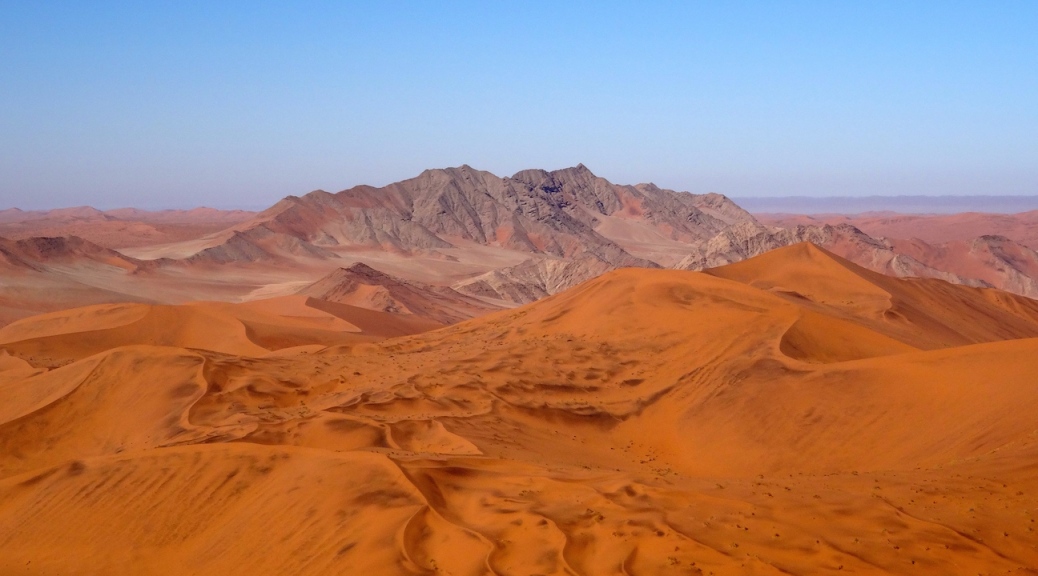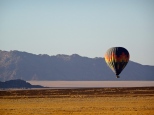After a rather indirect travel day from Camp Okavango in Botswana via South Africa and into Namibia (including a semi-lost, but later found, piece of luggage (Rich’s) for the first and only time on our year and a half of travels!) we found ourselves in Windhoek preparing to drive to the dunes of Sossusvlei.
The ride from the capital was beautiful. Just a few miles outside of the city we began to see baboons on the roadside, and we eventually made it to the Spreetshoogte Pass, which offered spectacular views of the Namib Desert. Apparently for those adventurous enough, you can camp here. I’d recommend it for one seeking extreme desert isolation.
To my delight, there were also kitschy roadside attractions on the way to Sossusvlei, and we stopped for lunch in the town of Solitaire (population: tiny). This itty-bitty metropolis features a gas station, restaurant, bakery and general store – and the only ones of those for many, many miles around. We stopped for all of the above amenities, including an oryx burger and a slice of their famous apple pie.
We also noticed a few massive sociable weaver nests on the acacia trees. These nests hold up to 300 birds! Sociable is right.
Our final stop on our way into the region was a quick visit to the Sesriem Canyon for a walk around the composite rocks striated from the impact of a long-gone river.
When we finally made it to Hoodia Desert Lodge, we were elated to see how beautiful it was. And the best part – it had air conditioning! But seriously, this is an incredibly gorgeous property with a cozy indoor common area full of leather couches, stunning views of the surrounding mountains and the (then dry) Tsauchab River, and the rooms are luxurious with great outdoor showers.
A quick drive from the lodge brings you to the Sesriem Gate, entrance to Namib-Naukluft National Park and its world famous red sand-dunes of Sossusvlei. We arrived early, as the sun was rising, and the views were incredible.
As you make your way down the long road towards the dunes you see hot air balloon riders floating above the red sands.
We also spotted a bit of wildlife, including some wild ostrich and oryx, Namibia’s national animal, with its huge straight horns.
The dunes, though, take center stage here. They are just spectacular.
Dune 45 is supposedly the most photographed, and it’s easy to see why. This magnificent dune catches the shadows in an artful way.
Bid Daddy, perhaps not surprisingly given the name, is the tallest, stretching up to 325 meters and dwarfing the surrounding dunes. We climbed up to the top of it. It’s a hot, grueling, two-steps-forward-one-step-back walk.
But the reward at the top…
360° views of nothin’ but sand, and down below you can see Deadvlei where we headed afterwards.
This video helps to give some perspective. Look for the people at the bottom of Deadvlei when the camera zooms in below.
But the best part of the trek: going down! While it took over an hour to hike up, we flew down in about 10 minutes. And wee!
Deadvlei is a dried riverbed made of clay, surrounded by Big Daddy and other dunes, and dotted with a forest of old, dead trees.
They have been stagnant for years, decomposition halted because the air is so dry. Deadvlei has not seen rain in a long time.
On our way out we saw a black-backed jackal wandering around the parking lot and walking right up to people eating. Scavengers have it easy when humans come along I suppose.
Practical Info
We traveled in Namibia with my mom and Rich on a private guided tour with Ultimate Safaris. Some folks travel independently to Namibia. We considered a self-drive trip, which means a travel agent would have made all the bookings and provided us with detailed maps and information and a 4WD rental. This does seem manageable, but I am happy we went with a guide. Our itinerary required a lot of driving on bumpy roads, we got a flat tire, and it was nice not to have to worry about getting around and booking activities etc. Later, Jenni and I traveled around South Africa on our own in a rental car, and that was very easy and pleasant.
Our guide Jimmy was very knowledgable on his country’s history, culture, wildlife and geography. Namibia is famed for its vast desert landscapes, sand dunes, animals, starry skies and more.
Perhaps most famous of those desert landscapes and sand dunes is Sossusvlei, which is the name of a specific salt and clay pan but often refers more generally to the Namib-Naukluft National Park and its characteristic large red dunes.
The currency is the Namibian Dollar, and at time of travel the exchange rate was ~ 1 USD = 11 NAD. South African Rand are accepted throughout Namibia (the rate is identical), but not vice versa.
Transportation: We arrived to Windhoek on a South African Airways flight from Johannesburg (having come from Camp Okavango in Botswana earlier in the day). The drive from the airport into the city takes 30-45 minutes. Jimmy was our guide and driver. Our vehicle was a Toyota Land Cruiser. Some ways are paved, but mostly in Namibia we were on reasonably smooth dirt roads. Pretty much everyone has a jeep or pickup truck or the like in this country.
We drove from Windhoek to Sossusvlei via the Spreetshoogte Pass, stopping in Solitaire and visiting Sesriem Canyon before arriving at our lodge. It was a fairly short drive (maybe 15-20 minutes) from the lodge to Sesriem Gate, and from there the paved road runs 60 km toward Sossusvlei (the pan). Where the pavement ends, one may either take a shuttle or drive the remaining 5 km through deep sand if one has the proper vehicle.
Accommodation: In Sossusvlei we stayed at Hoodia Desert Lodge. The property is stunning with stylish decor befitting owner Thomas’ prior profession as an interior designer. There are 11 stand-alone thatched chalets with air conditioning. The common area features a gorgeous lounge and dining room, a spacious deck with views and a small pool. While we have no hesitation recommending this place, we must note that the only way to really see the dunes at sunrise and beat the crowds is to stay inside the park gates.
In Windhoek, we stayed at the Hilton, and it was very nice. Our only complaint is that the free WiFi works only in the lobby, i.e. WiFi in your room is an extra charge.
Food and Drinks: We enjoyed lunch in Solitaire, and yes the apple pie is delicious. Other meals in the area were generally had at Hoodia Desert Lodge, where the food was great. Similar to our experience in South Africa, hotels tend not to gouge you on alcohol, which is delightful as you can enjoy perfectly fine bottles of South African wine for ~$15 even at a high-end property.
Dinner at the Hilton in Windhoek was quite good; the breakfast buffet was outstanding.
Activities: The highlight of the area is clearly visiting the red sand dunes and white pans of Namib-Naukluft National Park. The park gates open at sunrise, and there was a queue well in advance. Jenni and I hiked to the top of Big Daddy, the tallest sand dune around. We took the shorter route and needed an hour for the ascent. The views are glorious. We ran down the dune in about 10 minutes to Deadvlei, which is the white dry clay pan with dead trees you see in National Geographic photos. We never actually explored the pan of Sossusvlei itself, because after the exercise and especially the sun exposure we’d had enough. Note that some protection for your camera is advised as sand gets into everything.
We’re told that Dune 45 (so named because it is 45 km on the road past the Sesriem Gate) is the most photographed dune in the world. You could also hike that, or Big Mama, or probably various others.
On our way into the region on the first day, we stopped for about an hour at Sesriem Canyon. It is neat to see, but I would not be devastated to miss it. Hot air balloon rides are understandably popular around Sossusvlei.
October 17-20, 2014 (Friday-Monday)














































































